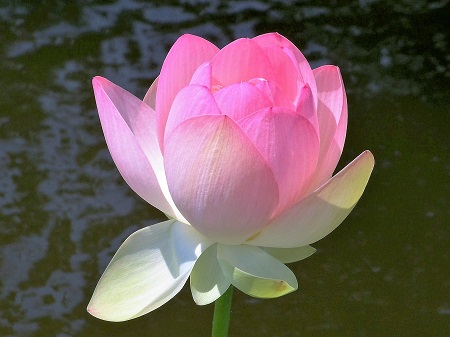Deciding How to Worship God
The quest for understanding how to worship God is a common inquiry in today's digital age. In this article, we delve into the intricacies of this spiritual endeavor.
Choosing a path of worship is a deeply personal journey, one that hinges on your intuitive connection with the divine. There are countless routes one can take, each offering its unique approach to achieving the ultimate goal: self-recognition as an intrinsic part of the divine. Some paths are more direct, while others meander through various aspects of spirituality and religion.
Regardless of the diversity of beliefs and practices, our perceptions of deities—whether they are portrayed in simple or elaborate forms—all ultimately represent the same divine source. The multiplicity of representations serves as a testament to the richness of human spirituality and our collective yearning to connect with the sacred.
When embarking on a path of worship, what truly resonates with you is the most fitting choice. Trust your inner compass to guide you in selecting the approach that aligns with your beliefs and convictions.
It's essential to remember that our interpretations of deities remain valid as long as we hold them in our hearts and minds. The journey towards God-Self recognition is a dynamic one, subject to individual evolution and growth.
At your core, you are an eternal manifestation of the One Holy Source, created in divine perfection. The key lies in recognizing this inherent truth, a realization that can profoundly transform your spiritual journey.
Yet, achieving this state of recognition can be challenging. Often, resistance arises from what some refer to as the "ego-mind." In Buddhist philosophy, this is known as the "monkey-mind." However, I personally prefer the term "ego-mind" as it avoids projecting a speculative understanding onto the thought processes of monkeys. After all, our own minds remain a subject of ongoing exploration and comprehension, making it humbling to draw comparisons to another species' cognition.
In conclusion, the path to worshiping God is as diverse and multifaceted as humanity itself. The key is to trust your inner wisdom, honor your chosen representations of the divine, and embark on the journey of self-recognition with an open heart and mind. Remember, you are eternally connected to the One Holy Source, and the quest for God-Self recognition is a profound, personal, and transformative experience.
Ego-Mind Tries to Compete With God
Exploring the Concept of Competing with the Divine
At first glance, the idea of competing with God might strike you as somewhat peculiar. However, within the teachings of A Course in Miracles, this concept finds a foundation in thoughtful reasoning.
Consider this: God, as understood in a nondualistic sense, exists beyond the realm of duality. Yet, many of the religious belief systems created by the ego-mind tend to be deeply entrenched in dualistic thinking. When we identify strongly with the ego-mind, we often find ourselves locked in a never-ending cycle of judgment and division.
Human nature predisposes us to engage in groupthink behavior, a tendency that inadvertently strengthens our ego-mind's dualistic view of the world, particularly when it comes to shaping our religions.
In this process, we often end up constructing religious systems that pit competing forces of good and evil against each other, attributing influence over our worldly experiences and outcomes to these disincarnate entities. The irony lies in the fact that these defined representations of God, created through dualistic lenses, cannot truly encapsulate the essence of the divine. After all, how can we possibly define the undefinable?
It's important to note that the creation of defined representations of God isn't limited to a single religion. Many belief systems incorporate numerous gods, each with their unique attributes and domains of influence. From Wicca and Paganism to Voodoo, Santeria, Hinduism, and even Catholicism with its veneration of the Blessed Virgin and numerous Saints, diverse religious traditions have created their own pantheons and celestial hierarchies.
These defined representations of gods and supernatural entities draw their power from collective belief and groupthink. As extensions of the One Holy Source, we humans possess an inherent creative capacity. We mold and shape these disincarnate beings and forces through the canvas of our collective imagination.
The message here is clear: Your creative imagination is a potent force. It has the ability to conjure intricate worlds of spirituality and belief. However, it's essential to recognize that these creations, while valuable as starting points for understanding the divine, can never fully encapsulate the boundless nature of God.
In conclusion, the notion of competing with the divine invites us to reflect on the ways in which our dualistic thinking and ego-driven constructs can sometimes hinder our true understanding of the sacred. It encourages us to embrace the creative aspect of our spirituality while remaining humble in the face of the ineffable, ever-expansive essence of the One Holy Source.

How to Worship God
Discovering Your Unique Path to Worship and Self-Realization
The journey of how to worship God is a deeply personal one, shaped by your own choices and inclinations. To embark on this path in the most practical and fulfilling way, consider crafting a daily practice that resonates with your intuition while simultaneously diminishing the influence of your ego-mind.
For many, incorporating familiar icons, symbols, and archetypes into their worship can be a valuable aid. This is because our upbringing and societal influences often condition us to relate to these representations. Embrace what feels comfortable for you, recognizing that it's merely the initial step on your spiritual journey.
One of the most straightforward techniques to reduce the grip of the ego-mind is to observe its activities as a nonjudgmental witness. Initially, this may appear somewhat unusual or even absurd, but it is remarkably effective.
As you persist in this practice, you will witness its transformative power firsthand. The key is to consistently observe without passing judgment. Whenever you find yourself entangled in an ego-mind outburst, gently return to the state of nonjudgmental witnessing.
Be prepared for resistance from your ego-mind; it will likely resist this practice vehemently. It understands that by engaging in mindful witnessing without judgment, its influence over you weakens.
Over time, as nonjudgmental witnessing becomes a habit, you will gradually identify more with your God-Self and less with your ego-mind. You'll come to realize that although you possess an ego-mind, you are not defined by it.
To assist you on your journey toward God-Self recognition, consider incorporating a straightforward meditation practice into your routine. This practice can serve as a valuable tool in deepening your connection to the divine within you.
Unveiling the Power of "Nam Myoho Renge Kyo" Chanting: A Path to Goal Manifestation
I chanted "Nam Myoho Renge Kyo" with some Buddhists back in the 1980s. Goal manifestation was what excited many participants.
Within Buddhist traditions, Nichiren Dai Shonin Buddhism stands out for its unique ritual practice involving the rhythmic chanting of "Nam Myoho Renge Kyo" in front of a sacred shrine known as a Butsudan. This distinctive practice not only connects individuals with their inner aspirations but also serves as a powerful tool for manifesting goals, even when the words themselves may seem cryptic or mysterious.
The Ritual and Its Significance
At the heart of Nichiren Dai Shonin Buddhism is the practice of chanting "Nam Myoho Renge Kyo" before a Butsudan, a cabinet housing a sacred shrine dedicated to the Lotus Sutra. The Lotus Sutra is a central text in Mahayana Buddhism, and "Nam Myoho Renge Kyo" is regarded as the distilled essence of its teachings. The practice involves the rhythmic repetition of this phrase, often accompanied by the recitation of one's personal goals and aspirations.
The Butsudan itself holds a special place in this ritual, serving as a focal point for the practitioner's devotion and connection to the divine. It is here that individuals place a list of their goals, written with clarity and intention. The act of posting these objectives in front of the Butsudan signifies a conscious effort to integrate spiritual values into the pursuit of worldly ambitions.
Goal Manifestation and the Power of Intention
The practice of chanting "Nam Myoho Renge Kyo" in front of a Butsudan with a list of goals is rooted in the belief that intention is a powerful force that can shape reality. Although the words themselves may initially appear cryptic or unfamiliar, the power lies not in their linguistic meaning but in the intention behind the practice.
- Clarifying Intentions: The act of setting and reciting one's goals while chanting "Nam Myoho Renge Kyo" encourages individuals to articulate their desires with precision and clarity. This process of introspection and goal-setting is essential for goal manifestation, as it helps individuals identify what they truly seek to achieve.
- Amplifying Focus: Chanting provides a focused and meditative state that aids in concentration and visualization. As individuals chant with unwavering intent, they are better able to align their thoughts and energies with their goals. This heightened focus amplifies the power of intention, bringing the desired outcomes closer to realization.
- Overcoming Inner Obstacles: Chanting "Nam Myoho Renge Kyo" also helps individuals address internal obstacles that may hinder goal manifestation. It encourages self-reflection, empowering practitioners to confront doubts, fears, and self-limiting beliefs. By transcending these inner barriers, individuals become more open to the possibilities of achieving their goals.
- Synchronizing with Universal Forces: The practice of chanting is believed to harmonize individuals with the universal rhythms and forces that govern the cosmos. In doing so, it creates a resonance between personal intentions and the broader flow of existence, increasing the likelihood of goal manifestation.
The Power Beyond Words
While the words "Nam Myoho Renge Kyo" may seem enigmatic to those unfamiliar with Nichiren Dai Shonin Buddhism, their transformative power transcends linguistic understanding. In this practice, the words serve as a conduit for intention, allowing individuals to tap into the profound energy of the universe.
- Beyond Linguistic Meaning: The efficacy of the practice is not contingent on the practitioner understanding the precise meaning of the words. Rather, it relies on the sincerity and devotion with which the words are chanted. The syllables themselves hold a vibrational resonance that connects individuals to a higher spiritual plane.
- Universal Harmony: "Nam Myoho Renge Kyo" is considered a universal language that transcends cultural and linguistic boundaries. It is a mantra that speaks to the interconnectedness of all beings and the unity of the human spirit. In this way, the practice fosters a sense of unity and oneness among its practitioners.
- Personal Transformation: The repetitive chanting of these words serves as a catalyst for personal transformation. It brings practitioners closer to their inner selves, fostering a deep sense of self-awareness and spiritual growth. This inner transformation is a crucial element in the process of goal manifestation.
Conclusion
The practice of chanting "Nam Myoho Renge Kyo" in front of a Butsudan with a list of goals offers a profound path to goal manifestation, even when the words themselves may seem mysterious. At its core, this practice harnesses the power of intention, clarity, and focus to bring about the realization of personal aspirations.
It reminds us that the language of the heart and soul transcends linguistic barriers, connecting us to a higher spiritual reality. Through this practice, individuals align themselves with universal forces, overcome inner obstacles, and embark on a transformative journey toward the manifestation of their goals.
Ultimately, whether the words "Nam Myoho Renge Kyo" are fully understood or not, their resonance with the human spirit and the universe is a testament to the profound potential of intention, devotion, and spiritual practice in shaping our lives and fulfilling our deepest aspirations.
"In God We Are One": A Spiritual Practice for Unity and Transformation
The power of words and their resonance in spiritual practice is undeniable. Inspired by the Nichiren Dai Shonin Buddhist ritual of chanting "Nam Myoho Renge Kyo" in front of a shrine, let us explore a new spiritual practice, one that carries a profound message of unity and oneness: chanting "In God We Are One." This practice, rooted in the belief in the interconnectedness of all beings and their divine essence, offers a transformative journey toward personal growth, inner peace, and the realization of our shared humanity.
The Essence of "In God We Are One"
"In God We Are One" encapsulates a powerful spiritual message that transcends religious boundaries and resonates with the universal truths of unity and interconnectedness. This phrase acknowledges that, at our core, we are all manifestations of the divine, bound together by a common spiritual thread that unites humanity. The practice of chanting these words before a shrine amplifies their impact, offering a tangible and focused avenue for spiritual growth.
Creating the Shrine Structure
To embark on this spiritual practice, the creation of a shrine structure is a meaningful step. The shrine serves as a sacred space that anchors your devotion and intention. While the form of the shrine can vary, here are some elements to consider:
- A Focal Point: Choose a central focal point for your shrine structure. This could be an altar, a table, or any dedicated space where you will conduct your practice.
- Symbols of Unity: Adorn the shrine with symbols that represent the concept of unity and oneness. Consider using images, art, or symbols from various spiritual traditions that resonate with you.
- Candles and Incense: Lighting a candle and burning incense can create a serene atmosphere and symbolize the illumination of divine wisdom and the purification of intentions.
- Personal Tokens: Include personal items or tokens that hold significance for you, reminding you of your connection to the divine and to humanity.
- Post images and/or lists associated with goal manifestation where you will see them as you chant.
Chanting "In God We Are One"
The heart of this spiritual practice lies in the rhythmic chanting of "In God We Are One" before your shrine structure. Here's how you can incorporate this practice into your daily life:
- Select a Time: Choose a time of day that works best for you. This could be in the morning to set a positive tone for the day or in the evening to reflect and find inner peace.
- Set Your Intention: Before beginning your practice, take a moment to set your intention. Reflect on what unity and oneness mean to you and how you wish to cultivate these qualities in your life.
- Chant Mindfully: Stand or sit comfortably in front of your shrine structure. Close your eyes or maintain a soft gaze. Begin chanting "In God We Are One" rhythmically, allowing the words to flow naturally. Focus on the resonance of the words and the intention behind them.
- Visualize Unity: As you chant, visualize a world filled with unity and oneness. Imagine individuals from diverse backgrounds and cultures coming together in harmony, recognizing their shared divinity.
- Feel the Connection: Allow yourself to feel a deep sense of connection with all living beings. Sense the divine presence within yourself and in every person you encounter.
- Repeat and Reflect: Continue chanting for a set duration, whether it's 10 minutes or longer. After your chanting session, take a moment to reflect on the feelings and insights that arose during the practice.
Transformative Benefits
The practice of chanting "In God We Are One" in front of a shrine structure offers numerous transformative benefits:
- Cultivating Unity: By repeatedly chanting these words, you reinforce your belief in the interconnectedness of all beings. This awareness can lead to a more compassionate and empathetic outlook on life, fostering unity in your interactions with others.
- Inner Peace: The practice provides a meditative experience that calms the mind and reduces stress. It brings a sense of inner peace and clarity, making it easier to navigate life's challenges with equanimity.
- Strengthening Intentions: Chanting while focusing on your intention for unity and oneness helps you stay aligned with your values and aspirations. This can guide your actions and decisions in everyday life.
- Heightened Awareness: As you practice regularly, you become more attuned to the divine presence within and around you. This heightened awareness enriches your spiritual journey and deepens your sense of purpose.
- Global Impact: The practice of "In God We Are One" extends beyond the individual. When more individuals embrace this practice, it has the potential to contribute to a more harmonious and compassionate world, where unity and oneness are celebrated and upheld.
- Goal manifestation, whether it be personal goals involving getting stuff, or manifesting beneficial outcomes generally, is facilitated through this sort of practice. Ritual chanting can be deeply meditative.
Conclusion
The spiritual practice of chanting "In God We Are One" in front of a shrine structure is a profound way to embrace unity and interconnectedness as core principles of your life. This practice transcends religious affiliations and invites individuals from all backgrounds to participate in a shared spiritual journey.
As you chant these words and create a sacred shrine, you not only transform yourself but also contribute to the collective consciousness of unity and oneness. "In God We Are One" becomes a powerful mantra that reverberates through your life, radiating its transformative energy to those around you and, ultimately, to the world.
Namaste

